Struggling with Poverty and Trauma, Millions of Afghans Turn to Drugs
Around 6 million Afghans are estimated to be addicted to drugs. Afghanistan is also the largest producer of opium in the world. Alive in Afghanistan talks to those most affected by drug use, the individuals and their families.

Reporting by Sima Siawash, Nazar Mohammad Razmal Zaman, Abdul Karim Azim, and Mirzahussain Sadid, written by Abdul Ahad Poya, edited by Mohammad J. Alizada and Brian J. Conley
“I have to find money for him, there is no other way, I take money from the mosque Mullah, from the neighbor’s wife, from my sister-in-law, from people passing by, because if I don’t, he threatens to kill me and my children,” Ms. Masooda, the mother of one of the drug users in Pul-e Sukhta, told Alive in Afghanistan.
Pul-e Sukhta is one of the most famous gathering spots for drug users in Afghanistan’s capital Kabul. For many years individuals who use drugs have congregated in the hidden spaces beneath bridges over the Kabul River. They are one of the many places Afghans can find a place to get high with their fellow outcasts. The bridges cross a portion of the Kabul river that is dry most of the year, other than the sewage waste that flows through it.
Masooda came to Pul-e Sukhta to take her son home but he escaped and is hiding among the hundreds of other drug users under the bridge. While crying, Ms. Masooda says, “I have tried to treat my son 15 times over the past 5 years since he started with drug addiction but he has escaped again. No state agency has helped me so far.”
According to Ms. Masooda, her 22 year-old son Omid forces her to give him cash although she doesn’t have enough to feed her family of nine. Her son has beaten her up several times over the years, one of her arms is broken in three places. Ms. Masooda says she wants the current government to put an end to this disaster.
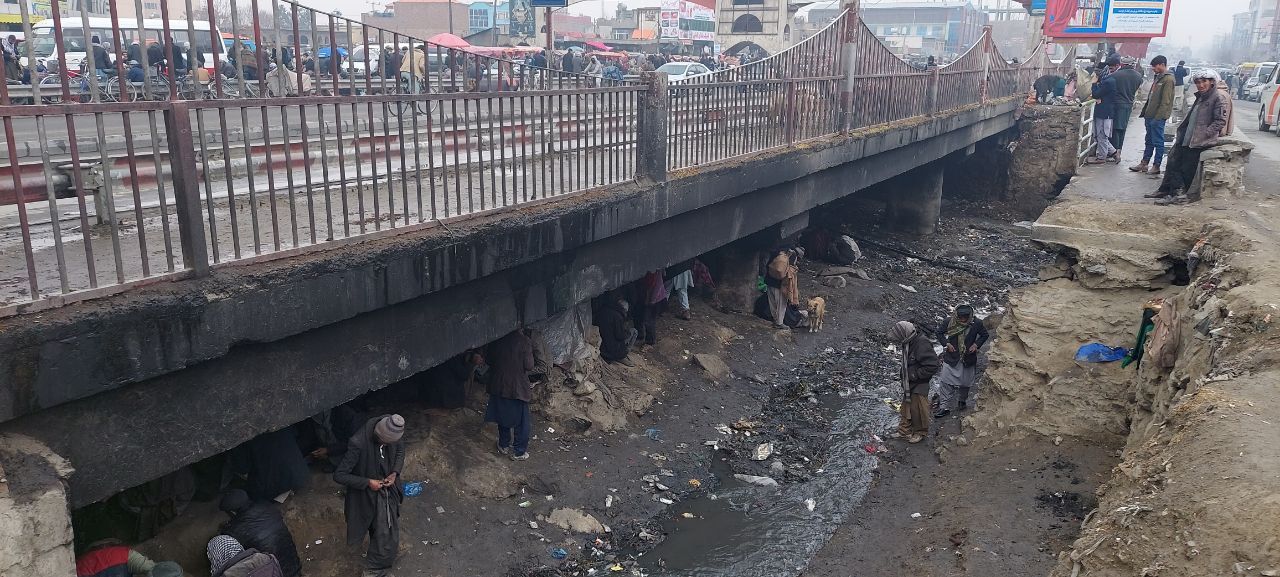
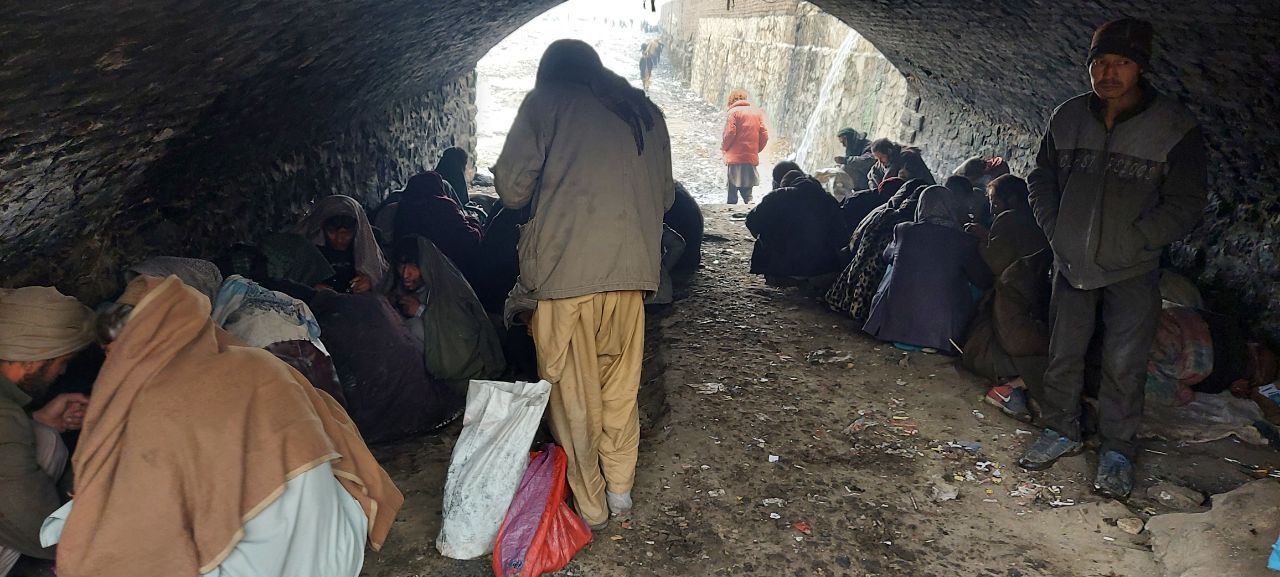
31 year-old Nazeef, another drug user, leans against one of the bridge columns. He is deep in his high. Nazeef is lying near the corpse of a man who may have died due to a drug overdose, yet Nazeef doesn't have a care in the world.
“I steal to find cash for drugs,” Nazeef says, “I sell anything that I can get my hands on.”
There are four dead bodies lying beneath the bridge but none of those who came there to use drugs seem to pay them any attention. Their families shunned them and have long forgotten.
Lack of awareness about the perils of addiction, and how to confront the causes of drug use as a family often leaves the families of drug users no choice but to shun them. Especially when efforts to provide the individual treatment fail. In many parts of Afghanistan there is no treatment facility available. The cost of their habit often leads drug users to steal from home, force family members to give them money, or steal from neighbors. The families feel the only choice they are left with is to kick their loved one out of home.
Abdul Khaliq, a 35 year-old drug user is married and has two kids.
“I got addicted to drugs 15 years ago in Iran, my roommates were taking drugs and I got used to it over time,” Khaliq says.
Abdul Khaliq is tired of his addiction to crystal meth. Living beneath a bridge in Kabul, Khalid misses his 8 year-old son and 4 year-old daughter who are still with their mother in Wardak province, a few hours away.
“I want to stop as well because everyone at home hates me and what I do,” Khaliq says. Although Khaliq believes using meth at home has a negative impact on his wife and children, he isn’t able to quit despite several tries.
According to him, drugs are sold freely in Char-rahi Qambar and Waisal Abad areas. He spends about 150 Afghanis (about $1.60) daily for drugs. He obtains this money by taking it from his wife or mother, by force if necessary.
Hashmat is a 33 year-old man from northern Kunduz province who has used drugs for the past 8 years. According to him, the pressures of his life got him addicted to drugs. Hashmat is also married and has 4 kids, all girls.
“I decided several times to stop but complete recovery is a very hard process, which is not possible without support and backup, otherwise you are going to relapse after two or three months,” Hashmat said.
Those using drugs who spoke to Alive in Afghanistan indicated several reasons behind their addiction, including poverty, being a refugee and their friendship with other drug users. The lack of law enforcement, exemption from legal punishment, ease of production, purchase, sale, and trafficking of narcotics are other reasons that drugs are so accessible in Afghanistan. Although these drugs are illegal across Afghanistan, these laws were never fully implemented.
The United States government spent nearly $9 billion between 2002 and 2021 to prevent the cultivation and trafficking of narcotics. Despite these efforts, Afghanistan is still the largest producer of narcotics in the world. According to the stories shared by those interviewed for this story, one of the ironies of Afghanistan’s production of narcotics is that they are not only exported; substance use has turned people’s lives in Afghanistan into a living hell.
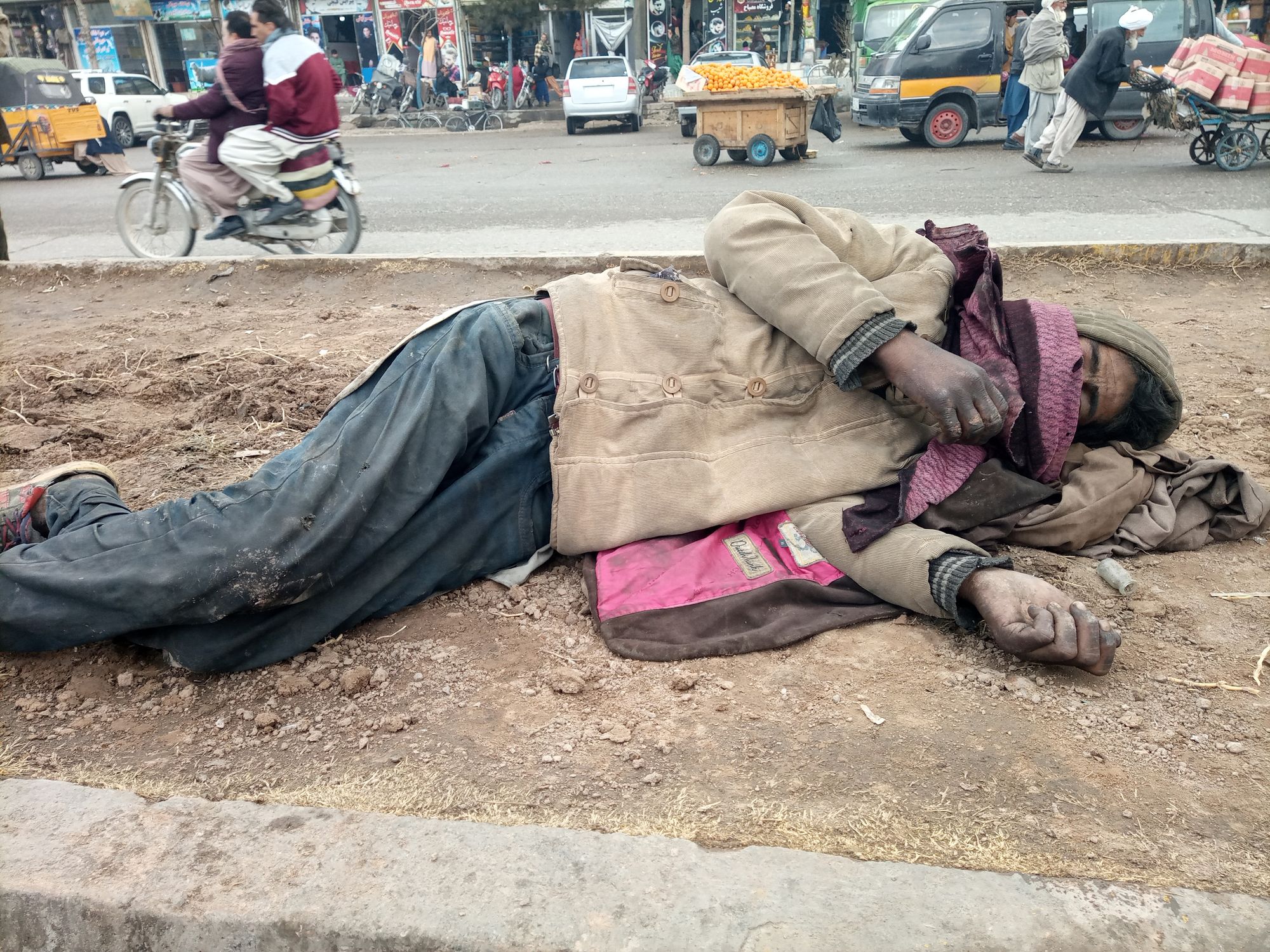
Mohammad is a 40 year-old resident of Herat who once was a mason but now works as a decorator at a drug treatment facility in the western province of Herat.
“Addiction to opium caused me to lose my mom, dad, wife and kids and live in abandoned homes,” Mohammad says.
At one time Mohammad made 1,500 Afghanis a day working as a mason (worth $20 at that time) yet hanging out with friends who had bad habits and his subsequent addiction forced him to beg for money, although his income should have made him fairly comfortable.
“I begged, ate food left in trash, stole, and didn’t stop at anything to find money for buying drugs. I did meth. This destructive addiction was with me for 20 years of my life, I used to wish someone would just take my hand and rescue me. Finally last year, a family member brought me to the rehab, they treated me and I got well. I now work at the same facility, make 200 Afghanis per day and have been an instrument and motivation for tens of other addicts to leave addiction.”
Mawalawi Zainuddin Zaheen, head of Counter-Narcotics Directorate for the Taliban in Herat claims that his agency is sending between 50 to 60 drug users to city rehab clinics daily for treatment.
According to Zaheen, "We are making efforts to apprehend the real perpetrators behind the drug problem and are trying to arrest traffickers, dealers and those involved in getting the youth into this evil phenomenon."
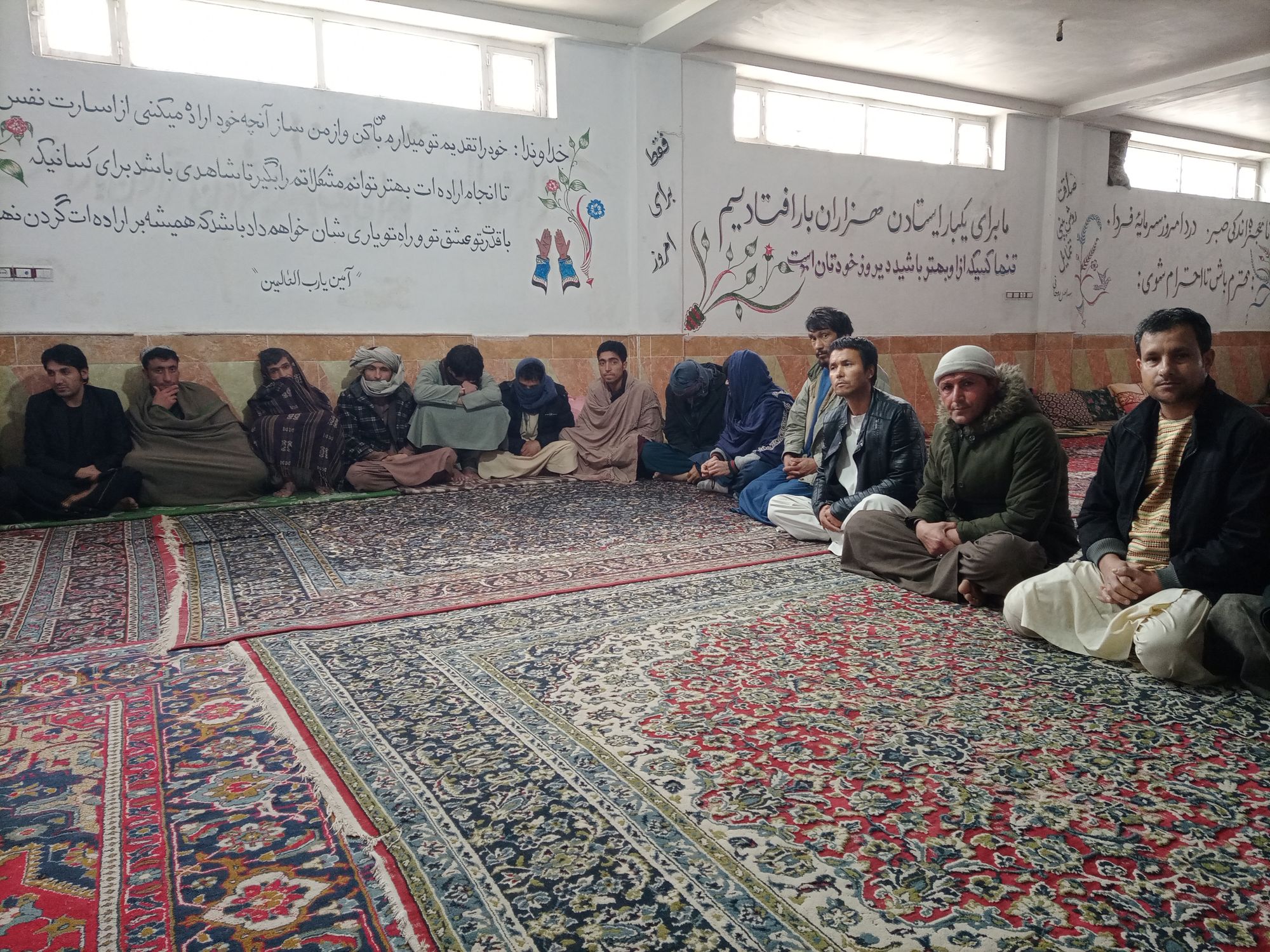
Abdul Hakim Azimi, head of Olguy-e Sabz Rehabilitation Center in Herat says more than 30 individuals are under treatment at the facility, some of whom have completed rehab and been handed over to their families.
The Olguy-e Sabz Rehabilitation Center has three phases, with each phase taking about 45 days to complete. So far the center has helped treat 400 people.
Mr. Azimi, a former substance user himself, established the rehabilitation center in late 2017 following his treatment, in the hopes of helping other drug addicts fight addiction.
34 year-old Sayed Murtaza from southern Helmand province who is under treatment at the center says hanging out with friends who were drug users got him started on drugs some 6 years ago.
According to statistics provided by the Counter-Narcotics Directorate of Herat, this year Herat is estimated to have nearly 70,000 drug users, 25 percent of whom are women. The Directorate says these drug users live in squalid conditions outside, and between 2 to 3 people die of cold every 24 hours.
Since the past two months the Taliban have arrested around 1,300 drug users from Herat and locked them up in the Herat prison for treatment that consists of immediate abstinence from drugs and repeated cold baths.
The total population of the province of Herat is currently estimated to be around 3.8 million. Just before the collapse, the population was estimated to be around 4.4 million. These estimates were provided by the Central Statistics Office of Herat.
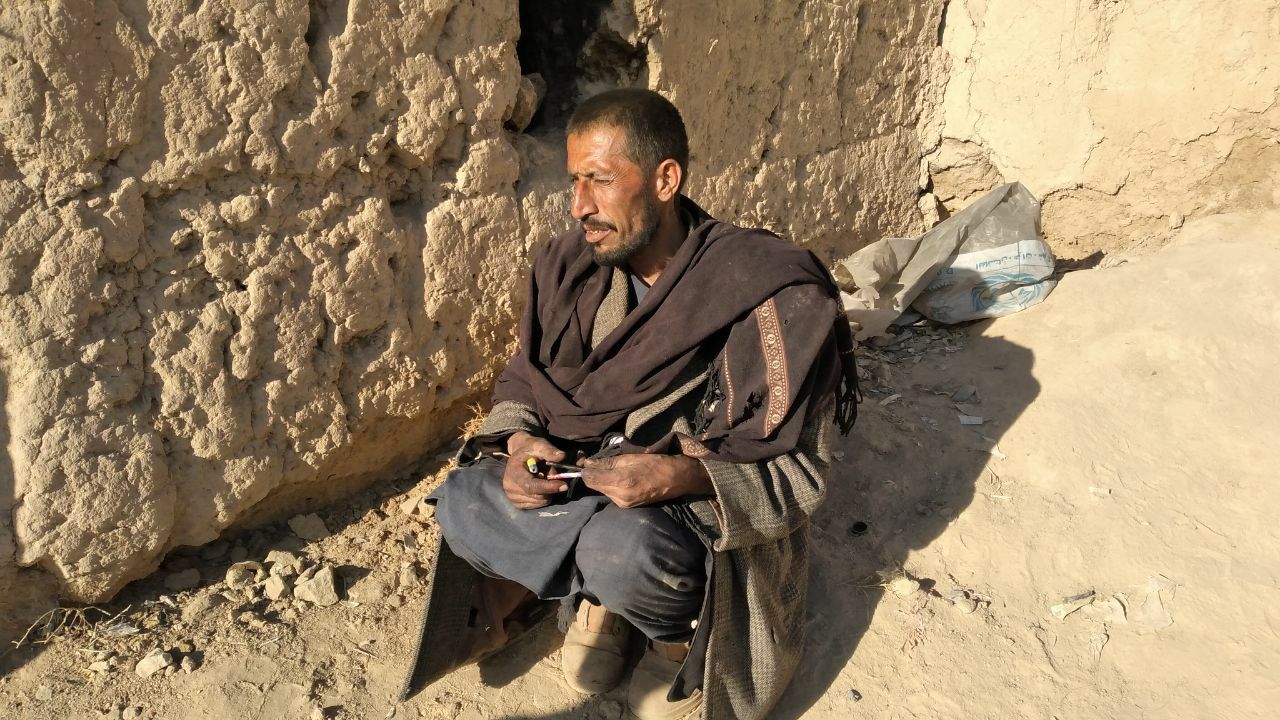
40 year-old Aminullah Noori is a resident of central Daikundi province who is married and has five kids. He has not been home for the past three months due to the embarrassment he feels from his drug use.
“The 50 or 100 Afghanis I make from selling scraps for buying drugs are sometimes taken away by the Taliban. They say we are buying poison anyways,” Mr. Noori says.
Mr. Noori was a policeman before the collapse of the western-backed Afghan government in mid-August last year. Even then he spent much of his salary on drugs.
Aminullah spends his days and nights in the ruins of a building in the corner of Nili, the capital of Daikundi, with 45 other drug addicts, two of whom are women.
55 year-old Abdul Hakim Mohammadi is an opium user who became addicted to drugs some 25 years ago in neighboring Iran. Today he is married to two women and has 14 children.
“My roommates told me that opium is good for getting rid of tiredness. We used to get really tired after work, get back to our room and get high,” Mr. Mohammadi told Alive in Afghanistan.
Jan Mohammad Rezayi, Daikundi’s head of Health Information Management System says, “86,000 people are addicted to drugs in Daikundi province, 27 percent of whom are women and children.”
Mr. Rezayi is concerned about the high number of drug addicts, according to him, the increase in number of drug addicts is due to ease of access to narcotics, lack of rehabs, and poverty.
At the moment, no rehabilitation centers for the treatment of substance use exist in Daikundi province, the two centers that started working in the field just before the collapse ceased operations following the Taliban takeover .
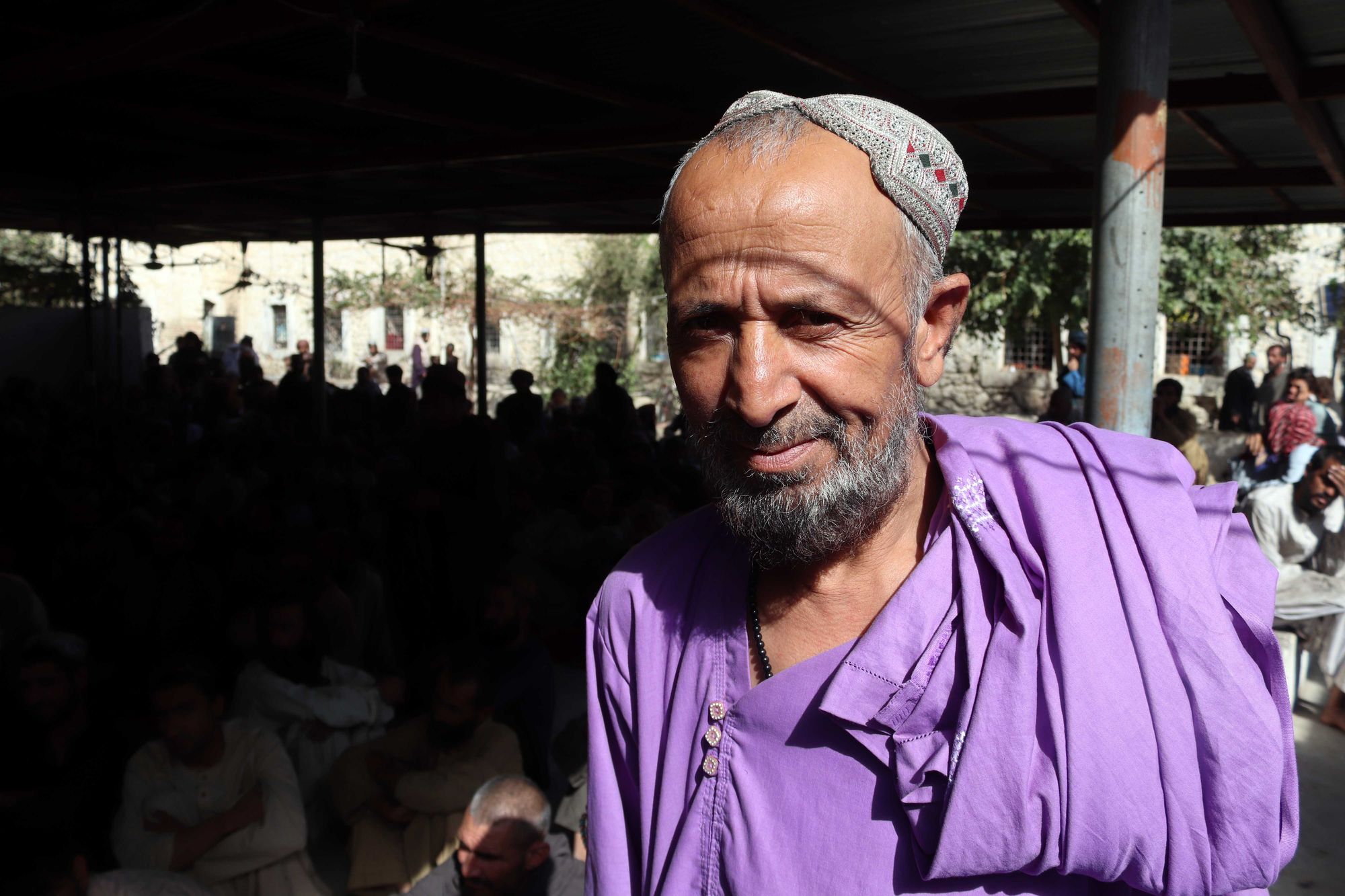
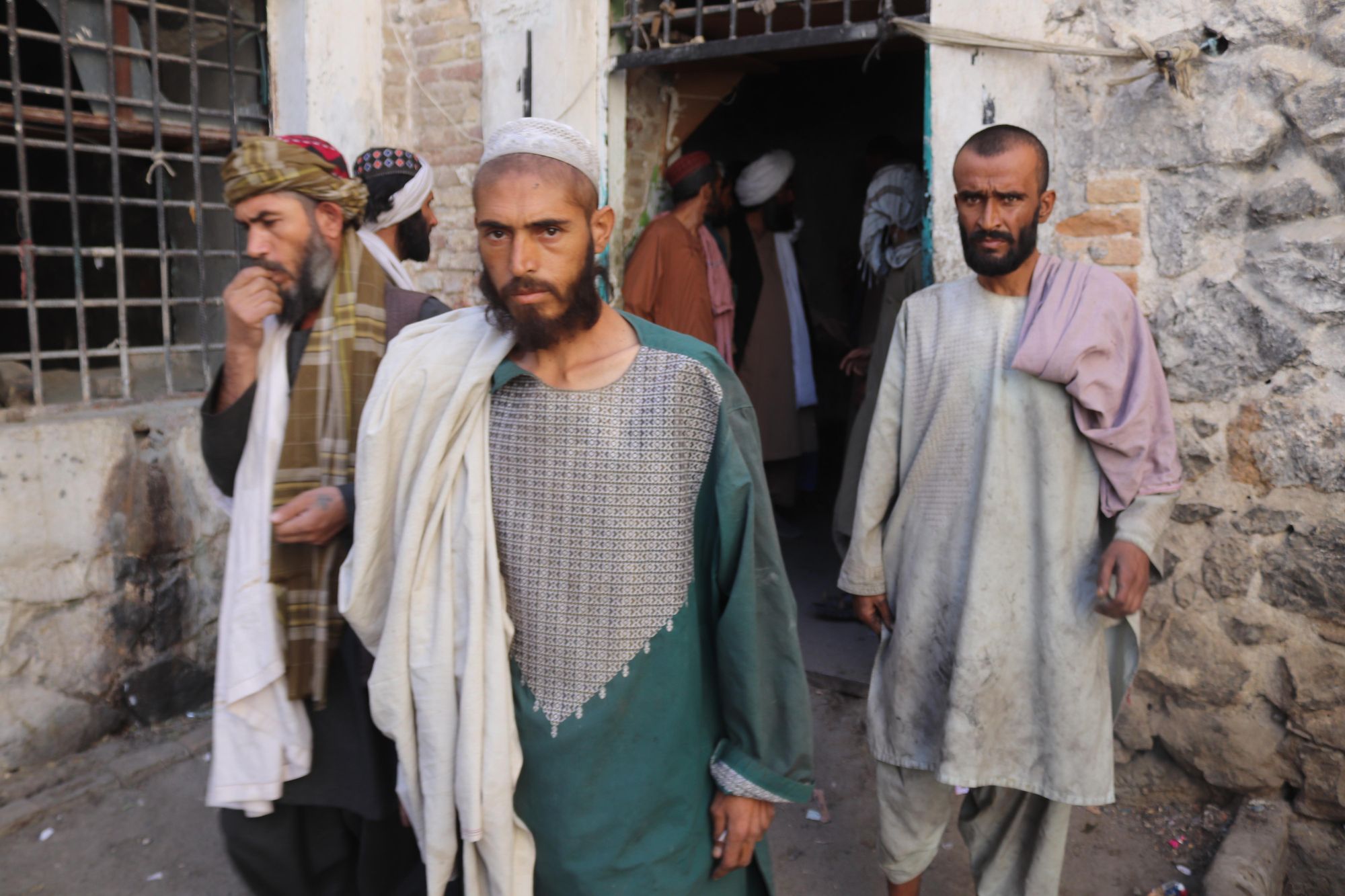
In southern Kandahar the number of drug users continues increasing by the day. The Taliban authorities in the province say they launched a campaign around two months ago, in which they rounded up 1,410 drug users and put them in the city prison.
The residents of Kandahar welcomed this move by the Taliban saying the use of drugs has decreased across the city since the Taliban warned drug dealers in the area.
Mawlawi Mohammad Ezam, the spokesman for Kandahar governor, says they have arrested 78 drug dealers in the past two months.
Although the drug users are kept as prisoners, however, Mawlawi Mansoor, deputy warden for Kandahar’s prison says, “The drug addicts are kept for treatment, we have built a clinic for them and they will be released after treatment. If they are not treated here, we will send them to bigger treatment centers.”
A number of drug users inside the prison seem happy with the move by the Taliban.
Mohammad Nabi, a resident of Arghandab district who has been in the prison for a month and a half says, “We are happy because we will once again be treated, we were all in a graveyard, didn’t eat for 3 or 4 days, now we get 3 meals a day, this is a good place for treatment.”
30 Year-old Ahmadullah, another drug user who was rounded up while using drugs is also happy with the move by the Taliban but a number of others are unhappy and report improper behavior, physical abuse and torture by the Taliban.
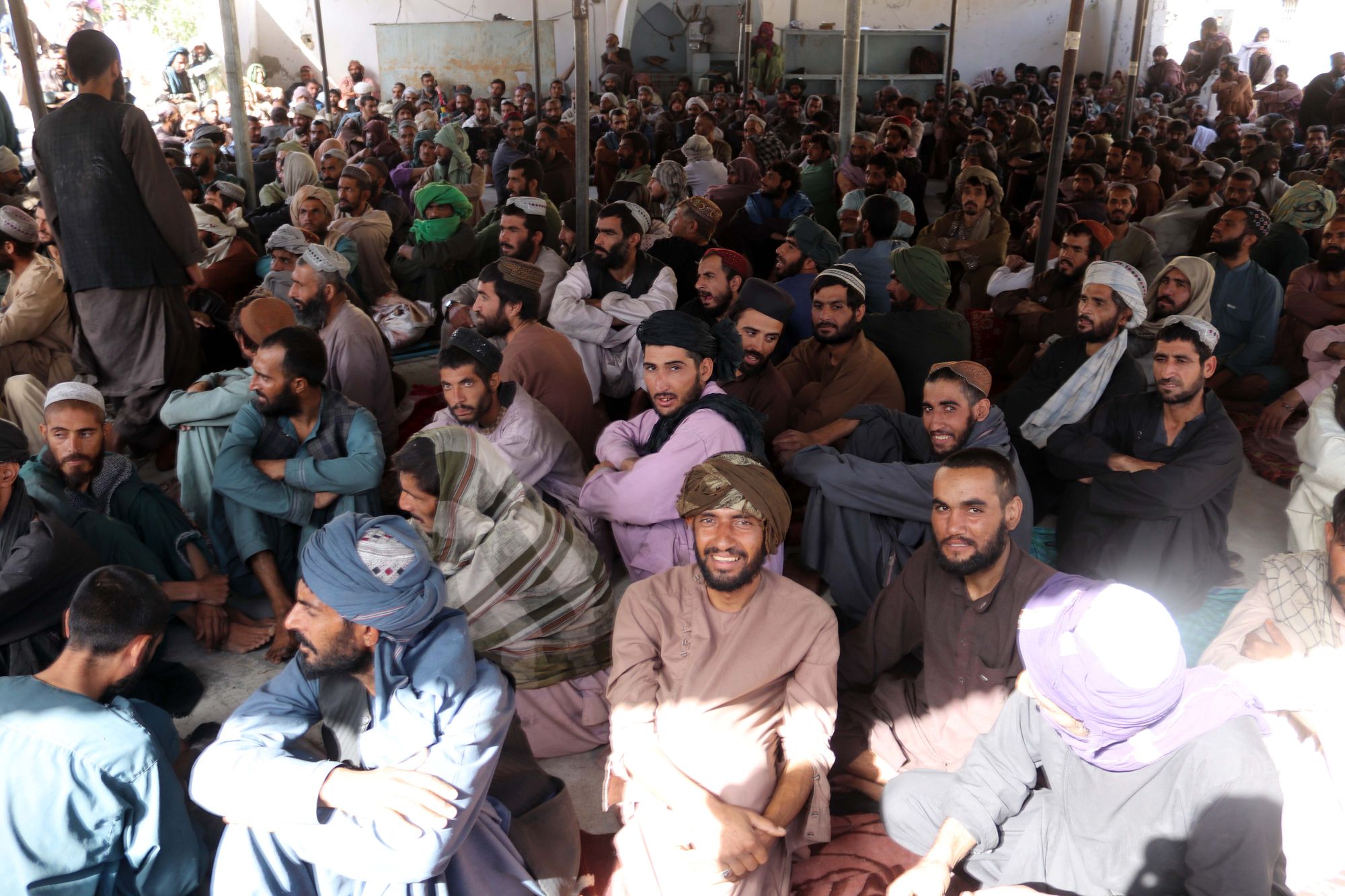
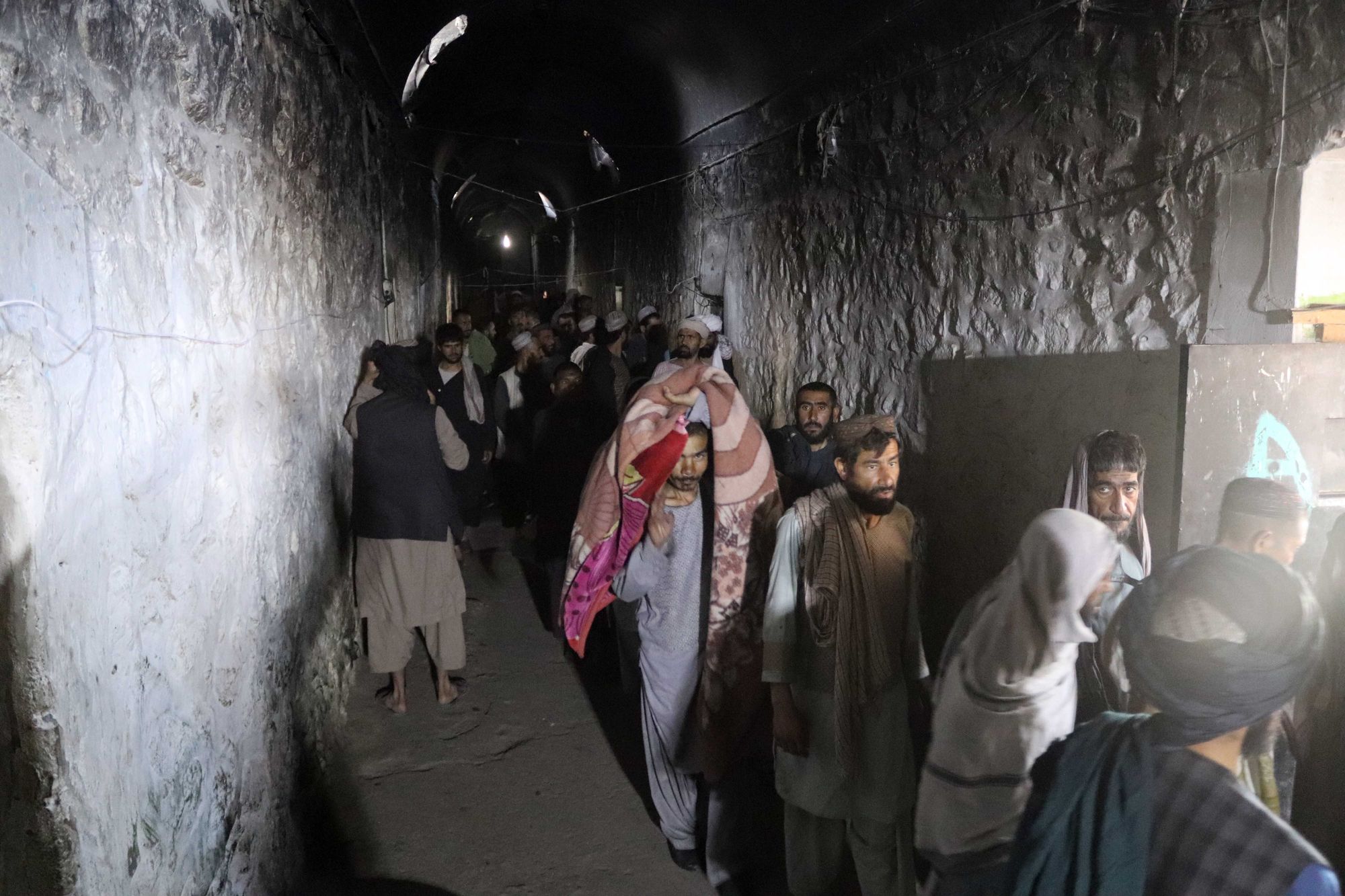
One of the prisoners who spoke to Alive in Afghanistan on condition of anonymity said, “I have been here for a month with no treatment, the authorities running the prison act in a very disgraceful and insulting manner with us, we are beaten and tortured.”
Dr. Musa Jan, Deputy Head of Kandahar's Public Health Directorate says, “According to a survey we did in 2019, more than 130,000 were addicted to drugs in Kandahar province, if a new survey is conducted, I am certain that number will show an increase because access to narcotics has gotten easier.”
Only 1 out of 3 rehab clinics in Kandahar is active right now, with the capacity to treat 500 drug users at a time. The other two were forced to close their doors due to a lack of resources and funding.
The number of drug users in Afghanistan is likely to increase as access to drugs remains easy and the Taliban’s ability to combat the phenomenon remains a question.
The Special Inspector General for Afghanistan Reconstruction (SIGAR), a U.S Congress watchdog, in a report published July 2019 said the Bureau of International Narcotics and Law Enforcement (INL), a State Department Agency spent at least $50 million of drug treatment projects in Afghanistan from January 2013 to April 2018, the agency does not know the impact of the investment.
Meanwhile Javid Hazhbar, the spokesman for Afghanistan’s Public Health Ministry says, “We have treated around 7,000 drug addicts over the past four months and currently have around 2,500 under treatment, including women and children.”
According to Mr. Hazhbar, the ministry is facing financial challenges.
“According to our latest statistics, some 2.9 million Afghans are addicted to drugs across Afghanistan and traces of narcotics have been found in the blood of 3.5 million others. Therefore we can say around 6 million Afghans are addicted to drugs,” Mr. Hazhbar says.
This article was the joint effort of Alive in Afghanistan (AiA) correspondents across four provinces of Afghanistan. The stories and data were gathered over December 2021 and January 2022.
